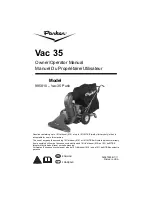
EN
- 9 -
Fitting the battery (Fig. 8)
Open the battery cover (Fig. 8/Item 19). To do so,
fl
ip the cover up as shown in Fig. 8. Then slot the
battery into the mount and push it forward until
you hear the battery engage.
6. Operation
6.1 On/O
ff
switch (Fig. 1/Item 2)
Switch position 0: O
ff
Switch position I: On
6.2 Dry vacuuming
Use the dust bag (14) and the additional
fi
lter (18)
for dry vacuuming (see point 5.2).
Always ensure that the
fi
lters are securely seated.
6.3 Wet vacuuming
For wet-vacuuming, use the foam
fi
lter (15) (see
point 5.2).
Check that the
fi
lter is securely seated at all times.
When wet-vacuuming, the
fl
oating safety switch
(Fig. 3/Item 5) closes when the maximum tank
level is reached. At the same time, the suction
noise of the equipment will change and become
louder.
You must then switch o
ff
the equipment and
empty the tank.
Danger!
The wet/dry vacuum is not suitable for the
vacuuming of combustible liquids. For wet
vacuuming, use only the supplied foam
fi
lter.
6.4 Blowing
Connect the suction hose (10) to the blow
connector (9) on the wet/dry vacuum.
6.5 Charging the Lithium-Ion battery
The corresponding instructions can be found
in the original operating instructions for your
charger.
6.6 Battery capacity indicator (Fig. 14 / item
25)
Press the battery capacity indicator switch (26).
The battery capacity indicator (25) shows the
charge status of the battery using 3 LEDs.
All 3 LEDs lit:
The battery is fully charged.
2 or 1 LED(s) lit:
The battery has an adequate remaining charge.
1 LED
fl
ashing:
The battery is empty, recharge the battery.
All LEDs
fl
ashing:
The temperature of the battery is too low. Remove
the battery from the device and leave it at room
temper-ature for a day. If the error occurs again,
this means that the battery has been completely
depth-discharged and is defective. Remove the
battery from the device. Never use or charge a
defective battery.
7. Cleaning and maintenance
HAZARD!
Always pull out the battery pack before starting
any cleaning work.
7.1 Cleaning
•
Keep all safety devices, air vents and the
motor housing free of dirt and dust as far as
possible.
•
We recommend cleaning the equipment
immediately each time after use.
7.2 Cleaning the
fi
lter (Fig. 1/Item 3)
Clean the equipment regularly with a damp cloth
and some soft soap. Do not use cleaning agents
or solvents; these may be aggressive to the
plastic parts in the equipment.
7.3 Cleaning the tank (Fig. 1/Item 7)
The tank can be cleaned with a damp cloth
and some soft soap or under running water,
depending on the amount of dirt.
7.4 Cleaning the
fi
lters
Cleaning the pleated
fi
lter (Fig. 2/Item 18)
Clean the pleated
fi
lter (18) regularly by carefully
patting it and cleaning it with a
fi
ne brush or hand
brush.
Cleaning the foam
fi
lter (Fig. 2/Item 15)
Clean the foam
fi
lter (15) with a little soft soap
under running water and allow it to air-dry.
7.5 Maintenance
At regular intervals and before each use, check
that the
fi
lters in the wet/dry vacuum are securely
fi
tted.
Anl_TC_VC_18_20_Li_S_USA_SPK7.indb 9
Anl_TC_VC_18_20_Li_S_USA_SPK7.indb 9
13.04.2022 13:59:14
13.04.2022 13:59:14










































